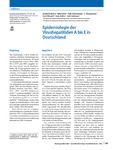2022-01-14Zeitschriftenartikel
Epidemiologie der Virushepatitiden A bis E in Deutschland
Dudareva, Sandra
Faber, Mirko
Zimmermann, Ruth
Bock, C.-Thomas
Offergeld, Ruth
Steffen, Gyde
Enkelmann, Julia
Mit Virushepatitis A bis E werden verschiedene infektiöse Entzündungen des Leberparenchyms bezeichnet, die durch die Hepatitisviren A bis E (HAV, HBV, HCV, HDV und HEV) ausgelöst werden. Zwar ähneln sich die Krankheitsbilder, die Erreger gehören jedoch zu verschiedenen Virusfamilien und unterscheiden sich bezüglich der Pathogenese, der Übertragungswege, des klinischen Verlaufs und der Präventions- und Therapiemöglichkeiten. In Deutschland besteht eine namentliche Meldepflicht nach Infektionsschutzgesetz (IfSG) für den direkten oder indirekten Nachweis und für Verdacht, Erkrankung und Tod. Die Daten werden an das Robert Koch-Institut übermittelt.
In diesem Beitrag wird die Epidemiologie der Hepatitiden A bis E anhand publizierter Studien und Meldedaten beschrieben und es werden aktuelle Herausforderungen und Präventionsansätze aufgezeigt. Letztere bestehen insbesondere in der verbesserten Umsetzung bereits bestehender Impfempfehlungen (Hepatitis A und B), dem verbesserten Zugang zu Prävention, Testung und Versorgung, einschließlich Therapie mit antiviralen Medikamenten (Hepatitis B, C und D), und der Erkennung und Verhinderung lebensmittelbedingter Infektionen und Ausbrüche und Verbesserungen auf dem Gebiet der Lebensmittelsicherheit (Hepatitis A und E). Viral hepatitis A to E describes various infectious inflammations of the liver parenchyma that are caused by the hepatitis viruses A to E (HAV, HBV, HCV, HDV, and HEV). Although the clinical pictures are similar, the pathogens belong to different virus families and differ in terms of pathogenesis, transmission routes, clinical course, prevention, and therapy options. In Germany, there is mandatory reporting according to the Infection Protection Act (IfSG) for direct or indirect laboratory evidence and for suspicion, illness, and death of viral hepatitis. The data are transmitted to the Robert Koch Institute.
In this article, on the basis of published studies and notification data, we describe the epidemiology of hepatitis A to E as well as current challenges and prevention approaches. In particular, the latter contains the improvement of existing vaccination recommendations (hepatitis A and B); improvement of access to prevention, testing, and care including therapy with antiviral drugs (hepatitis B, C, and D) and the detection and prevention of foodborne infections and outbreaks; and improvements in the field of food safety (hepatitis A and E).
Files in this item
Related Items
Show related Items with similar Title, Author, Creator or Subject.
-
2022-01-14ZeitschriftenartikelEpidemiologie der Virushepatitiden A bis E in Deutschland Dudareva, Sandra; Faber, Mirko; Zimmermann, Ruth; Bock, Claus-Thomas; Offergeld, Ruth; Steffen, Gyde; Enkelmann, JuliaMit Virushepatitis A bis E werden verschiedene infektiöse Entzündungen des Leberparenchyms bezeichnet, die durch die Hepatitisviren A bis E (HAV, HBV, HCV, HDV und HEV) ausgelöst werden. Zwar ähneln sich die Krankheitsbilder, ...
-
2015-07-06ZeitschriftenartikelOccult Hepatitis B Virus Infection in Nigerian Blood Donors and Hepatitis B Virus Transmission Risks Oluyinka, Opaleye O.; Tong, Hoang Van; Tien, Sy Bui; Fagbami, Ademola H.; Adekanle, Olusegun; Ojurongbe, Olusola; Bock, Thomas; Kremsner, Peter G.; Velavan, Thirumalaisamy P.Background: Occult hepatitis B virus infection (OBI) characterized by the absence of detectable HBsAg remains a potential threat in blood safety. We investigated the actual prevalence, viral factors and genotype of OBI ...
-
2014-05-16ZeitschriftenartikelMolecular Epidemiology and Genotyping of Hepatitis B Virus of HBsAg-Positive Patients in Oman Baqlani, Said Ali Al; Sy, Bui Tien; Ratsch, Boris A.; Naamani, Khalid Al; Awaidy, Salah Al; Busaidy, Suleiman Al; Pauli, Georg; Bock, ThomasBackground: Hepatitis B virus (HBV) infection is a major global health burden with distinct geographic public health significance. Oman is a country with intermediate HBV carrier prevalence; however, little is known ...

